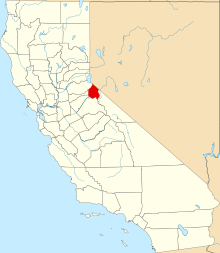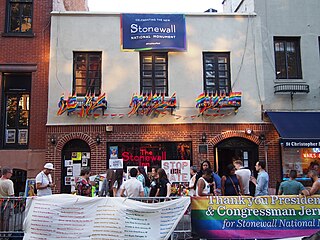
Lesbian, gay, bisexual, transgender and queer (LGBTQ) movements are social movements that advocate for LGBTQ people in society. Although there is not a primary or an overarching central organization that represents all LGBTQ people and their interests, numerous LGBTQ rights organizations are active worldwide. The first organization to promote LGBTQ rights was the Scientific-Humanitarian Committee, founded in 1897 in Berlin.
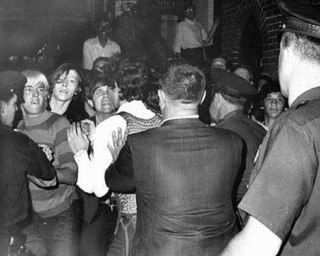
The Stonewall riots were a series of spontaneous riots and demonstrations against a police raid that took place in the early morning hours of June 28, 1969, at the Stonewall Inn, in the Greenwich Village neighborhood of New York City. Although the demonstrations were not the first time American homosexuals fought back against government-sponsored persecution of sexual minorities, the Stonewall riots marked a new beginning for the gay rights movement in the United States and around the world.
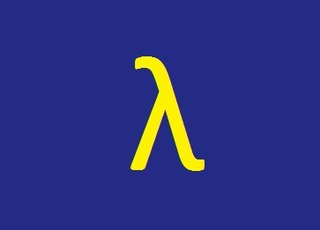
The Gay Activists Alliance (GAA) was founded in New York City on December 21, 1969, almost six months after the Stonewall riots, by dissident members of the Gay Liberation Front (GLF). In contrast to the Liberation Front, the Activists Alliance solely and specifically served to gay and lesbian rights, declared themself politically neutral and wanted to work within the political system.

Gay Liberation Front (GLF) was the name of several gay liberation groups, the first of which was formed in New York City in 1969, immediately after the Stonewall riots. Similar organizations also formed in the UK, Australia and Canada. The GLF provided a voice for the newly-out and newly radicalized gay community, and a meeting place for a number of activists who would go on to form other groups, such as the Gay Activists Alliance, Gay Youth New York, and Street Transvestite Action Revolutionaries (STAR) in the US. In the UK and Canada, activists also developed a platform for gay liberation and demonstrated for gay rights. Activists from both the US and UK groups would later go on to found or be active in groups including ACT UP, the Lesbian Avengers, Queer Nation, Sisters of Perpetual Indulgence, and Stonewall.

The gay liberation movement was a social and political movement of the late 1960s through the mid-1980s in the Western world, that urged lesbians and gay men to engage in radical direct action, and to counter societal shame with gay pride. In the feminist spirit of the personal being political, the most basic form of activism was an emphasis on coming out to family, friends, and colleagues, and living life as an openly lesbian or gay person.
Queer nationalism is a phenomenon related both to the gay and lesbian liberation movement and nationalism. Adherents of this movement support the notion that the LGBT community forms a distinct people due to their unique culture and customs.

The NYC Pride March is an annual event celebrating the LGBTQ community in New York City. The largest pride parade and the largest pride event in the world, the NYC Pride March attracts tens of thousands of participants and millions of sidewalk spectators each June, and carries spiritual and historical significance for the worldwide LGBTQIA+ community and its advocates. Entertainer Madonna stated in 2024, "Aside from my birthday, New York Pride is the most important day of the year." The route through Lower Manhattan traverses south on Fifth Avenue, through Greenwich Village, passing the Stonewall National Monument, site of the June 1969 riots that launched the modern movement for LGBTQ+ rights.

Street Transvestite Action Revolutionaries (STAR) was a gay, gender non-conforming, and transvestite street activist organization founded in 1970 by Sylvia Rivera and Marsha P. Johnson, subculturally-famous New York City drag queens of color. STAR was a radical political collective that also provided housing and support to homeless LGBT youth and sex workers in Lower Manhattan. Rivera and Johnson were the "mothers" of the household, and funded the organization largely through sex work. STAR is considered by many to be a groundbreaking organization in the queer liberation movement and a model for other organizations.
This is a list of notable events in the history of LGBT rights that took place in the 1960s.
This is a list of notable events in the history of LGBT rights that took place in the 1970s.

Pride is the promotion of the rights, self-affirmation, dignity, equality, and increased visibility of lesbian, gay, bisexual, transgender and queer (LGBTQ) people as a social group. Pride, as opposed to shame and social stigma, is the predominant outlook that bolsters most LGBTQ rights movements. Pride has lent its name to LGBTQ-themed organizations, institutes, foundations, book titles, periodicals, a cable TV channel, and the Pride Library.

Craig L. Rodwell was an American gay rights activist known for founding the Oscar Wilde Memorial Bookshop on November 24, 1967 - the first bookstore devoted to gay and lesbian authors - and as the prime mover for the creation of the New York City gay pride demonstration. Rodwell, who was already an activist when he participated in the 1969 Stonewall uprising, is considered by some to be the leading gay rights activist in the early, pre-Stonewall, homophile movement of the 1960s.
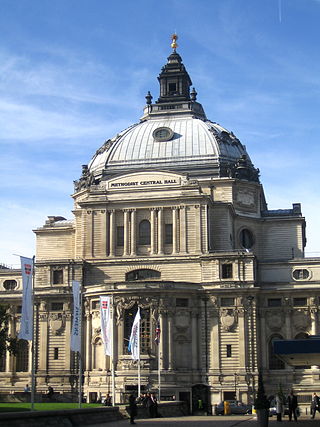
On 9 September 1971 the UK Gay Liberation Front (GLF) undertook an action to disrupt the launch of the Church-based morality campaign Nationwide Festival of Light at the Methodist Central Hall, Westminster. A number of well-known British figures were involved in the disrupted rally, and the action involved the use of "radical drag" drawing on the Stonewall riots and subsequent GLF actions in the US. Peter Tatchell, gay human rights campaigner, was involved in the action which was one of a series which influenced the development of gay activism in the UK, received media attention at the time, and is still discussed by some of those involved.
The North American Conference of Homophile Organizations was an umbrella organization for a number of homophile organizations. Founded in 1966, the goal of NACHO was to expand coordination among homophile organizations throughout the Americas. Homophile activists were motivated in part by an increase in mainstream media attention to gay issues. Some feared that without a centralized organization, the movement would be hijacked, in the words of founding member Foster Gunnison Jr., by "fringe elements, beatniks, and other professional non-conformists".
The Annual Reminders were a series of early pickets organized by gay organizations, held yearly from 1965 through 1969. The Reminder took place each July 4 at Independence Hall in Philadelphia and were among the earliest LGBT demonstrations in the United States. The events were designed to inform and remind the American people that gay people did not enjoy basic civil rights protections.
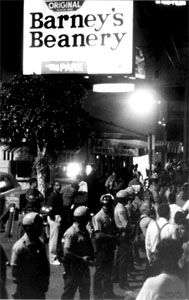
A zap is a form of political direct action that came into use in the 1970s in the United States. Popularized by the early gay liberation group Gay Activists Alliance, a zap was a raucous public demonstration designed to embarrass a public figure or celebrity while calling the attention of both gays and straights to issues of gay rights.

New York City has been described as the gay capital of the world and the central node of the LGBTQ+ sociopolitical ecosystem, and is home to one of the world's largest and most prominent LGBTQ+ populations. Brian Silverman, the author of Frommer's New York City from $90 a Day, wrote the city has "one of the world's largest, loudest, and most powerful LGBT communities", and "Gay and lesbian culture is as much a part of New York's basic identity as yellow cabs, high-rise buildings, and Broadway theatre". LGBT travel guide Queer in the World states, "The fabulosity of Gay New York is unrivaled on Earth, and queer culture seeps into every corner of its five boroughs". LGBTQ advocate and entertainer Madonna stated metaphorically, "Anyways, not only is New York City the best place in the world because of the queer people here. Let me tell you something, if you can make it here, then you must be queer."
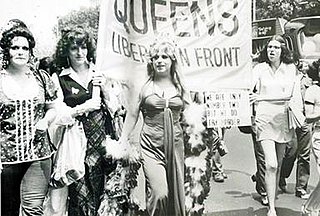
Queens Liberation Front (QLF) was a homophile group primarily focused on transvestite rights advocacy organization in New York City. QLF was formed in 1969 and active in the 1970s. They published Drag Queens: A Magazine About the Transvestite beginning in 1971. The Queens Liberation Front collaborated with a number of other LGBTQ+ activist groups, including the Gay Activists Alliance and the Street Transvestite Action Revolutionaries.

Charles Pitts was an American gay activist and radio personality. He co-hosted The New Symposium on New York City's WBAI from 1968 to 1969, the first weekly public radio program to offer an affirming discussion of homosexuality by openly gay hosts. After the Stonewall Riots, he co-founded the Gay Liberation Front in New York City and continued his audio activism through the program Homosexual News. From 1971 to 1973, his weekly WBAI show Out of the Slough broke barriers as the first freeform radio show centered on gay politics and culture.

Come Out! was an American LGBT newspaper that ran from 1969 to 1972. It was published by the Gay Liberation Front (GLF), a gay liberation group established in New York City in 1969, immediately following the Stonewall riots. The first issue came out on November 14, 1969, it sold for 35 cents, and 50 cents for outside of New York City. Its run only lasted for eight issues. Its tagline for the first paper was: "A Newspaper By And For The Gay Community".
